Axolotl Tank Set Up & Maintenance – What Else Can Live with Axolotls?
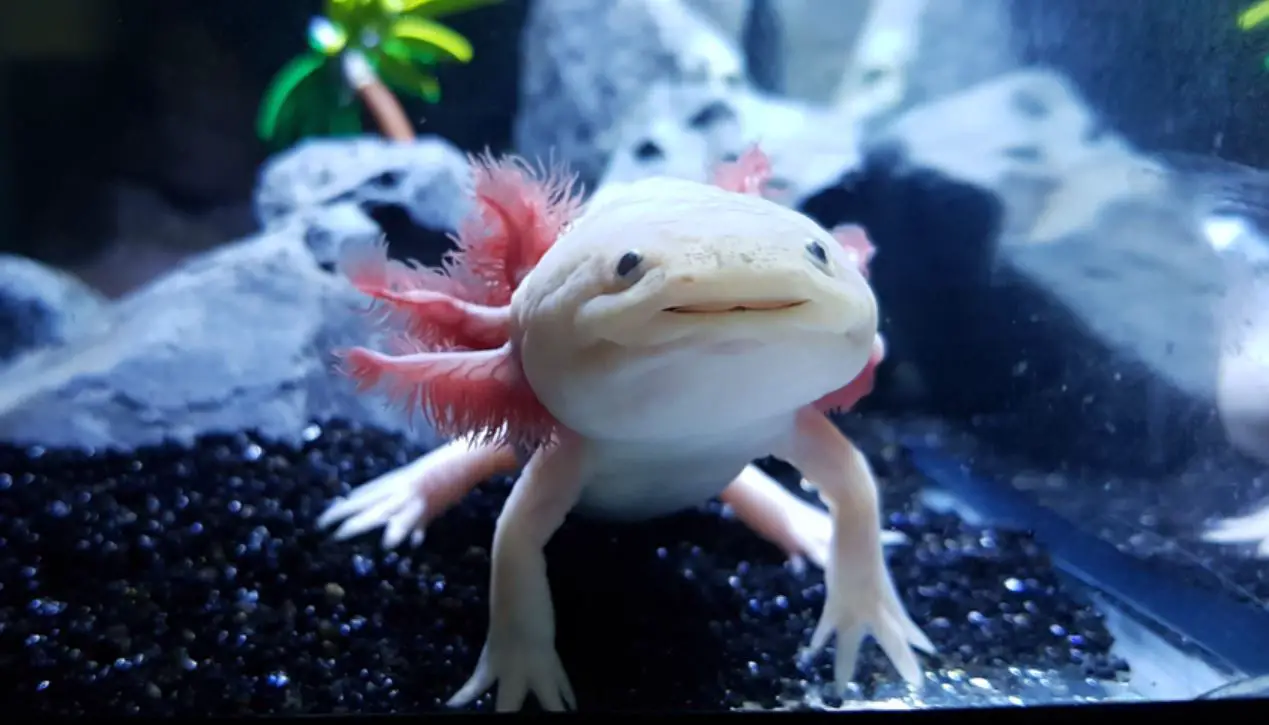
Sometimes known as the ‘Mexican Salamander’ the Axolotl makes a unique pet. It is also sometimes referred to as the ‘Mexican walking fish’ but in actual fact, it is not a fish at all but an amphibian, as explained in Wonderopolis.org. Axolotls have become increasingly popular over recent years, with many deciding to keep one as a pet.
If this is something you are planning to do, it is important to be properly prepared. Familiarising yourself with the needs of this amphibian is vital, and this includes learning about how to set up and maintain its tank as well as finding out what other creatures it can live with harmoniously.
Getting Ready to Set Up Your Axolotl Tank
So, if you’ve done your research and decided that the Axolotl is the right pet for you, one of the key things you need to do is to set up a tank for the new addition to your home. It is very important to ensure you do this correctly and that you get the right tank for the Axolotl’s needs. So, here are some key points to keep in mind when it comes to setting up a tank for your new pet:
Get the Right Aquarium
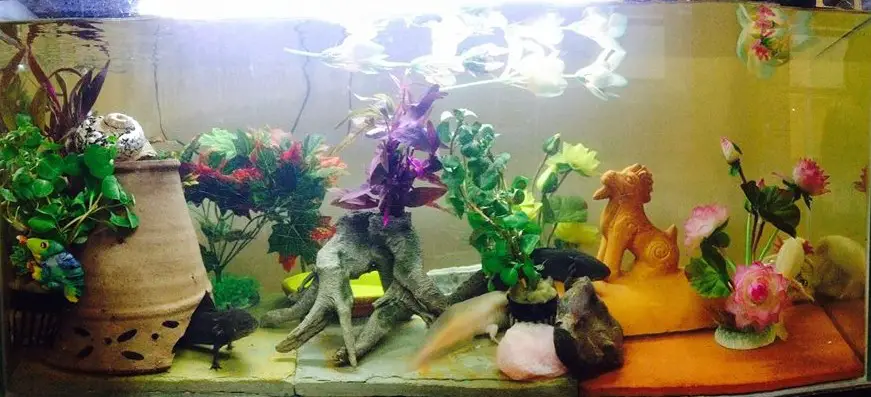
It is important to ensure you invest in an aquarium that is the right size for your Axolotl. Some people decide to start with a smaller tank of around 10 gallons with the intention of upgrading once the Axolotl goes grows into an adult. However, you are much better off going for a larger tank in the first place such as 20 gallons according to The Beta Pet.
Also, it is worth remembering that the Axolotl does not make use of vertical space, so you should look for a tank that is long rather than tall. In addition, remember you will need a bigger tank if you plan to have more than one Axolotl – as a rule of thumb, there should be an additional ten gallons for each additional Axolotl.
Choose a Suitable Filter
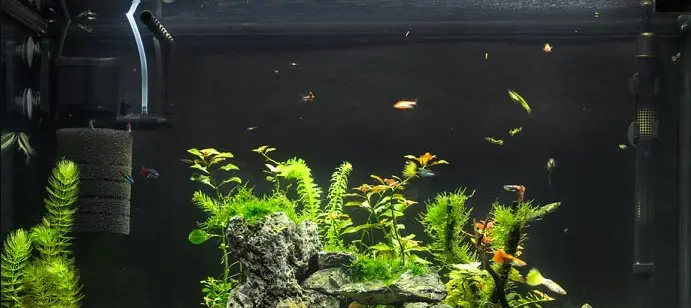
It is important to choose the right filter for your tank, and when doing this you should keep in mind that these salamanders are not keen on strong flows of water according to PetMD. Many opt for a sponge filter, as these will work perfectly for Axolotls. For this type of filter, you will also require an air pump, which should be a powerful one to ensure effective filtration.
Invest in a Heater
It is advisable to get a heater or a chiller for the tank, as this can help to combat fluctuations in temperature at different times of the day or night. However, you do not need a particularly powerful one because the Axolotl is a cold-water species and does not respond well to higher temperatures.
Get a Water Testing Kit
In order to ensure your Axolotl enjoys a safe and comfortable environment, it is important that you monitor the water quality. For this, you will need to invest in a water testing kit, and the recommended option is the liquid testing kit. Choose one that can test the water for ammonia, nitrate, and pH levels so you can be sure that the water quality is okay.
Select the Right Lighting
When it comes to lighting, don’t be tempted to go for strong lighting for your Axolotl tank. Much like Gremlins, these creatures are not keen on bright light and can become quite distressed if the lighting is too powerful. So, go for something that is subtle so you can see the Axolotl but not cause any unnecessary stress.
Provide a Suitable Substrate
Another thing you have to think about is the most suitable substrate for your Axolotl tank. Some people consider gravel, but your Axolotl is likely to consume anything that fits into its mouth, and this includes bits of gravel! According to axolotl.org, this could prove fatal. So, you should look at alternatives such as large stones for the bottom of the tank or even sand, as this can pass easily through the Axolotl’s digestive system if it is consumed.
Plants and Decorations
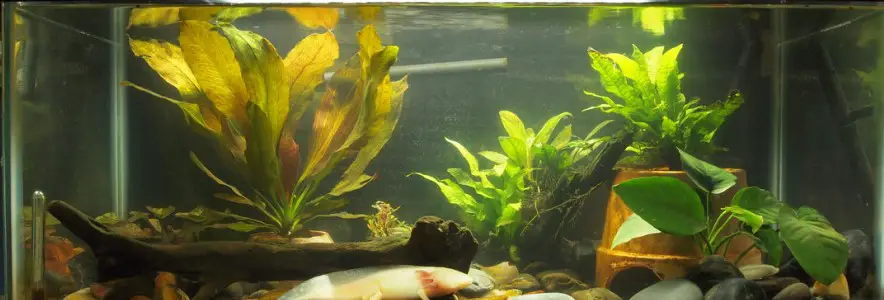
With the right plants and decorations, you can create a wonderful underwater environment for your Axolotl. Not only will plants and decorations make the tank look attractive, but it will also provide your new pet with some much-appreciated hiding places where it can enjoy some chill-out time.
In addition, the plants can help to boost the quality of the water in the tank. Plants such as Java Fern and Water wisteria are recommended for Axolotl tanks. Caudata.org offers further advice on choosing the right plants and aqua-scaping.
You can use products such as driftwood and large calcium-free rocks to enhance the décor. You will also find plenty of hides you can select from to enable your pet to hide away whenever it wishes to. Some of these are beautifully designed and can help to add an eye-catching touch to the tank.
Choose the Right Room
One other thing you have to do is make sure you choose the right room for your Axolotl tank. It is important that the conditions in the room where the tank is placed are ideally suited to your pet, so you must make your selection carefully.
You should choose a room where there is not a lot of bright light or daylight streaming in at all times. In addition, choose a room that is cooler during the day and night – as mentioned earlier, Axolotls do not appreciate high temperatures.
Setting Up and Maintaining Your Axolotl Tank
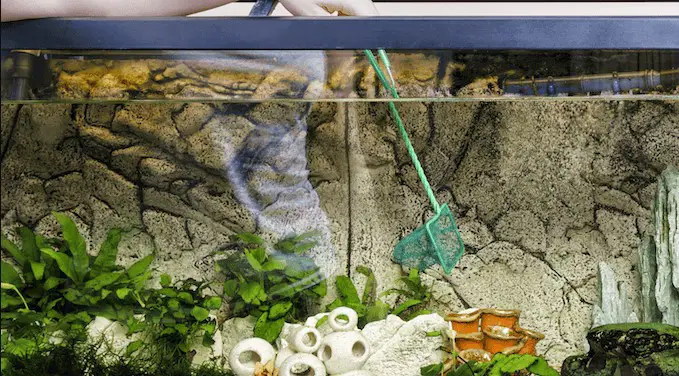
So, now you have everything you need, and you have selected a suitable room in your home, it is time to get your tank set up. When doing this, you should follow these steps:
Clean the Tank
When you first purchase your tank, you need to ensure you clean it thoroughly using hot water. Also, do the same with the accessories. You never know what harmful bacteria could be in the tank or accessories when you first buy them, and you don’t want to put your new pet’s health or life at risk.
Some people purchase tanks and accessories second-hand, and it is especially important to wash and clean them thoroughly in this situation, as there could be lots of harmful bacteria lurking around. So, make sure you clean all materials to remove any remaining bacteria.
Start Cycling!
So, the first thing you need to get cracking with is cycling the aquarium. To do this, you need to fill the tank with water and switch on the heater and filter. You may also wish to add your decorations at this stage, although you can do this later if you prefer.
The purpose of cycling is to help the filter and substrate to accumulate ‘good’ bacteria, which will make the tank a safe place for your Axolotl. To perform the cycling process, you need to add ammonia while also testing the water. This helps to boost the growth of good bacteria. You can learn more about the cycling process in this video.
Once the cycling process is complete, you can continue with the remainder of the set-up process. You should make sure that all materials and equipment are now in place. This includes the filter and pump, the heater, lighting, substrate, plants and decorations, and hiding places for your Axolotl.
The Temperature of the Water
Always keep in mind the importance of keeping the water in the tank at the right temperature for your Axolotl. For the health of your pet, you should try to maintain the water temperature at around 64 °F. If the water gets colder than this, your salamander may start to show signs of lower energy levels, as it can slow down their metabolic rate.
The main danger when it comes to water temperature is letting the water get too hot, as this is something that can prove dangerous or fatal for your pet. You should never let the water temperature reach 75 degrees or more.
Water Values
You also need to ensure you keep the water values in check. Ammonia, nitrate, and nitrite are all involved in the cycling process, as demonstrates in the video above. After the cycling process, the levels of ammonia and nitrite should be zero, as these can otherwise result in the death of your Axolotl.
When it comes to nitrate, this is okay at lower levels, but you should make sure that the level does not rise to over 15. If it does, you need to take steps by changing the water in the tank in order to reduce the nitrate levels.
In addition to this, you need to ensure that you test how alkaline or acidic the water is, which you can do by using a pH test kit. The ideal pH level for the Axolotl is between 7 and 7.5. However, most Axolotls will be okay with pH levels of between 6.5 and 8.
As explained by vet R.Loh at the World Small Animal Veterinary Association Congress several years ago, water quality is of the utmost importance when it comes to the health and wellbeing of these creatures.
One final thing to consider when it comes to water values is how hard the water is. These creatures thrive well in hard water, and when it comes to water hardness you should aim for 100ppm at a minimum. The maximum hardness level should be 200ppm.
What Other Creatures Can Live with Axolotls?
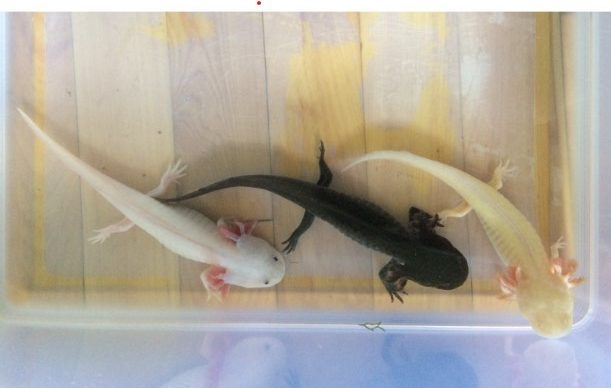
There are lots of you that may be considering getting an Axolotl but also have other water-babies. Naturally, the first instinct is to introduce your new Axolotl as a tank mate for your existing pets. On the other hand, you may already have an Axolotl and you might be considering other species to introduce as tank mates.
If this is something you are thinking about, you should keep in mind that although Axolotls can live with other water creatures such as fish, it is not the best idea. It can cause a lot of stress and suffering on both sides, so your best option is to keep your Axolotl alone. These creatures thrive in isolation, so you won’t have to worry about your pet getting lonesome.
There are a few creatures you may be able to consider if you are really eager to do so, but you must remember that there is a risk that they may get eaten by your Axolotl! This includes:
Mini Snails
Mini snails are a popular choice because they are bottom feeders, and this means they can help to keep harmful bacteria growth at bay. They can help to get rid of bits of food that are left over by your Axolotl, which then reduces the risk of bad bacteria.
Guppies
Like mini snails, guppies are bottom feeders and can help to get rid of your Axolotl’s leftovers. However, their small size and soft exoskeleton mean that they will probably also double up as a snack for your Axolotl.
Minnows
These fish tend to be peaceful and keep themselves to themselves, which is what makes them potentially suitable for your Axolotl tank. Having said that, there is still a risk that they will get eaten by your Axolotl.
Of course, your best bet is to choose another of the same species as a tank mate – another Axolotl. However, do remember that for each additional one, you should have ten extra gallons, so you will need a bigger tank.
Also, remember that if you do have additional Axolotls and you fail to provide adequate space for each one, it could lead to territorial fights. This can then result in injuries and even fatalities of the weaker of the creatures. Axolotls value their space, so this is something that you need to keep in mind.
Enjoy the Quirky Beauty and Uniqueness of Your New Pet!

While being the owner of an Axolotl does come with its responsibilities, once you have everything set up you can look forward to being the proud owner of a quirky, unique pet. Just make sure you maintain your pet’s living environment properly so it can enjoy feeling relaxed and comfortable in the tank.
The good news is that, as pointed out in Reptile Magazine, this species is pretty easy to care for. By creating an attractive environment for your Axolotl, you can also create a stunning centrepiece in your chosen room. The right plants, decorations, and hiding places can help you to create a beautiful aquarium that creates a real focal point in the room.


